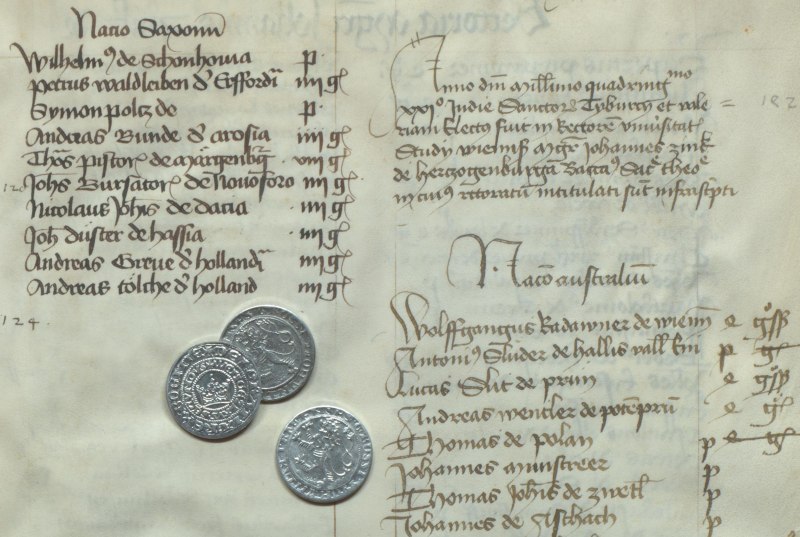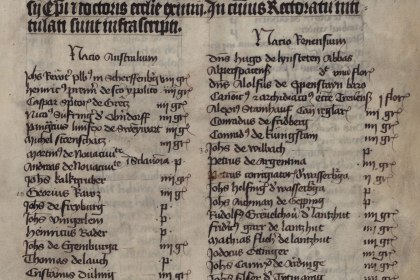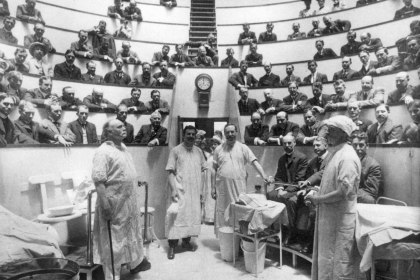Study costs in the Middle Ages and the early Modern Age
“Free education”, “against tuition fees”, “no social selection” and similar demands are often put forward in the – sometimes fiercely, sometimes not so vigorously fought – debate about universities and in particular their financing. In this context, it is often also argued that there had supposedly been no admission restrictions in the past and that it had therefore been possible for “the poor” to study.
How was the situation at the University of Vienna in actual fact? The medieval university statutes did indeed not include any limitations in regard to the students’ financial situation and even offered partial exemptions from fees for poor people. An overview of the costs that accrued during the studies, however, shows that while these exemptions somewhat mitigated the financial burden, studying at the university still put an enormous strain on the students’ wallets. When compared to contemporary wages, a university education was hardly affordable for people with a low income.
The University of Vienna – like other medieval universities – was open to students regardless of their financial background. This general openness should however not be confused with the now often discussed expression of “(cost-)free education”. Along the way into and through the university, fees became due regularly. Poor students (also called pauperes) could be exempted from some of these fees, but a complete course of studies at the university still meant a large burden for the students’ and their families’ finances.
Basically, study costs could be divided into two groups: On the one hand there were direct study costs, payable to the university. On the other hand, the living expenses had to be covered.
Study costs
Students already had to pay their first fee when joining the university. The matriculation consisted of the entry into the register, an oath to uphold the university statutes and certainly not least of the payment of the matriculation fee. This payment was also recorded in the register. The fee was not the same for all students, but changed with regard to the faculty chosen and the students’ social status. From 1413 onwards students at the Faculty of Arts paid twelve Kreuzer for the entry into the register, while those at the Faculties of Theology, Law or Medicine had to pay 24 Kreuzer. The fee for magisters or doctors from other universities was higher than that for normal students, with matriculation fees of 15 and 30 Kreuzer.
Clergy and nobility also had to pay higher fees: They ranged from 30 Kreuzer for members of the lower nobility and cathedral canons up to three guilders (180 Kreuzer) for dukes and bishops. Poor students, in contrast, did not have to pay matriculation fees.
Just as the matriculation marked a student’s entry into the university, the Deposition made the new student (“Grünschnabel” – “greenhorn”) part of the student body. The fee for this ceremony was six Kreuzer.
After overcoming these first financial obstacles, fees for lectures and disputations became due. These varied according to the read book. At the faculty of arts, lecture fees ranged from six to 36 Kreuzer, while teachers at the faculty of law received one guilder per study year for their held lectures. Disputation fees were twelve to 72 Kreuzer. In the course of the 15th century, these fees were raised several times. With the 1554 Reformatio Nova the costs for obligatory lectures at the faculty of arts were abolished, since the professors were now paid by the Landesfürst (local sovereign).
There is almost no information on the costs of books and writing materials. Hand-written books were unaffordable for most students, but also printed books – usually cheaper than hand-written ones – had prices starting at about one guilder, equivalent to the yearly fee for professors at the Faculty of Law or the matriculation fee for abbots or barons. Because of this, the Faculty of Arts held dictation hours (pronunciationes), at which students could write their own copies.
If you wanted to graduate, this also came with its own costs. Once a student had finished his doctorate, he had to pay fees to the faculty, the examiners, the participating magisters and doctors as well as to the caretaker. These fees ranged from eight Kreuzer for the caretaker to two guilders for the faculty and the doctors. The usually much higher costs for the following celebration can only be estimated with difficulty. They included the graduate’s ceremonial clothing, music, presents for the attendees and the traditional doctor’s feast. Some reports about doctorates name costs up to 200 guilders, which explains why only few students aspired to graduate.
Living expenses
Apart from these study costs the students also had to cover the daily costs of living. Mainly, this meant costs for housing and food, as well as clothing, leisure activities and possibly medical care.
Since a large part of Viennese students came from outside of Vienna, they had to look for accommodations in the city. Those students that did not find places in bursae and coderies controlled by the university took lodgings with citizens. Yearly rent in a bursa amounted to between five and seven guilders, which probably included additional costs such as heating and tuition. Expenses for the bed or other furniture were usually not included. Rent in a coderie, a student alms house was about three to four guilders.
There are varying reports on whether these prices also included meals. This presumably differed from bursa to bursa.
Other expenses such as clothing depended strongly on the students’ financial background. Thus, no general statements can be made about them.
Total costs of studying at the Faculty of Arts
Assertions about the total costs of studying at the University of Vienna can only be seen as approximations, since the accruing costs are only partially known. Most reports are in regard to the Faculty of Arts, and since also the majority of students studied here, the statements will be restricted to this faculty. Yearly study costs, including possible graduations, ranged from 14 to 21 guilders. Poor students were able to reduce these costs to between four and six guilders due to exemptions from fees.
Comparing these numbers to contemporary wages shows that even if a student was classified as a pauper, studying was not affordable – or only with great difficulty – for large parts of the population: A servant at the Viennese Bürgerspital (citizens’ hospital) received a yearly wage of just under one guilder. A cook was paid three and a half guilders and the hospital director received 15 guilders.
This comparison makes it clear why the phenomenon of the “working student” was already prevalent in the Middle Ages and why there was a large number of mainly private scholarship foundations. Even with various exemptions from fees for so-called “poor” students, attending a university was only really possible for people from a good financial background.
Zuletzt aktualisiert am 10/11/24



